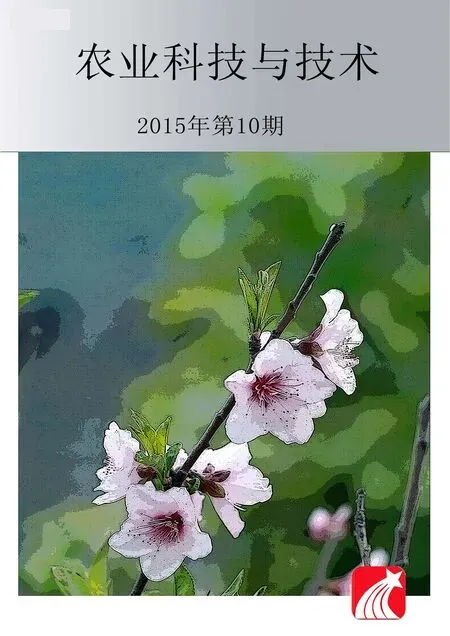Extraction and Structure Elucidation of Phenols from Dendrobium thyrsiflorum
Ruixuan WENG,Yupeng Ll,Shuang Ll,Guihua ZHANG,Ying WANG,Xiaoling WEN,Jun ZHANG,Rong HUANG
1.School of Pharmaceutical Science&Yunnan Key Laboratory of Pharmacology for Natural Products,Kunming Medical Universi-ty,Kunming 650500,China;
2.Department of personnel,Kunming Medical University,Kunming 650500,China;
3.Advanced Analysis and Measurment Center,Yunnan University,Kunming 650091,China
Extraction and Structure Elucidation of Phenols from Dendrobium thyrsiflorum
Ruixuan WENG1,Yupeng Ll1,Shuang Ll1,Guihua ZHANG1,Ying WANG1,Xiaoling WEN2*,Jun ZHANG1,Rong HUANG3*
1.School of Pharmaceutical Science&Yunnan Key Laboratory of Pharmacology for Natural Products,Kunming Medical Universi-ty,Kunming 650500,China;
2.Department of personnel,Kunming Medical University,Kunming 650500,China;
3.Advanced Analysis and Measurment Center,Yunnan University,Kunming 650091,China
[Objective]This study aimed to investigate the chemical constituents of Dendrobium thyrsiflorum and determineitsbioactive compounds. [Method]The compounds were extracted by 95%alcohol and isolated by column chromatography on silica gel and Sephadex LH-20.Their structures were identified by spectroscopic analysis(1H NMR and13C NMR).[Result]Seven compounds were obtained and iden-tified as 4,7-dihydroxy-2-methoxy-9,10-dihydrophenan-threne(1),syringaldehyde(2),moscatin(3),gigantol(4),batatasin III(5),tristin(6)and stigmasterol(7).[Conclusion]Compounds 1 and 2 were isolated from this medicinal plant for the first time.
Dendrobium thyrsiflorum;Medicinal plant;Chemical constituents
T he genus Dendrobium includes about 1100 species which are widely distributed throughout Asia,Europe and Oceania[1].In lit-erature review,we found that the medicinal plants of this genus were used to nourish stomach,promote the production of body fluid and reduce fever[2].In recent years,the investiga-tion disclosed that this medicinal plant mainly contains phenolic compounds,such as bibenzyls,phenanthrenes and fluo renones[3-7].We researched this medicinal plan in order to find new bioactive components from this Chi-nese famous traditional herb.In this paper,we reported herein the isolation and structure elucidation ofseven compounds from D.Thyrsiflorum.
Plant Materials and Meth-ods
General
Column chromatography (CC):silica gel(200-300 mesh),TLC:silica gel GF254,1H NMR and13C NMR spectra:Bruker AM-500 and DRX-500 spectrometer with CDCl3and(CD3)2CO as solvent and TMS as internal stan-dard.
Plant materials
The herbs of D.thyrsiflorum were collected from Xishuangbanna of Yunnan Province in 2013,China.A voucher specimen of this collection was deposited at Herbarium of Kun-ming MedicalUniversity,Kunming,China.
Methods
Air-dried and powdered herbs of D.thyrsifloum (3.5 kg)were soaked with EtOAc five times at room temper-ature.After the evaporation of EtOAc extract,the extract was subjected to column chromatography over silica gel eluted with petroleum ether:ethyl ac-etate gradient(10∶0,9∶1,8∶2,7∶3,6∶4,1∶1,0∶1)and gave 7 fractions (Fr1-Fr7).Fr3(11.28g)waschromatographed over a column of silica gel with gradi-ent elution by petroleum ether:ethyl acetate(8∶1,7∶1,6∶1,5∶1,4∶1,3∶1,2∶1, 1∶1)to isolate compounds 1-7,and filtration through SephadexLH-20 column eluted with MeOH∶H2O(1∶1).
Results and Analyses
1H NMR and13C NMR spectra were used to identify compounds 1-7.Compounds 1 and 2 were isolated from the herbs for the first time.The structures of all compounds were elucidated as follows(Fig.1).
Compound 1:4,7-dihydroxy-2-methoxy-9,10-dihydrophenanthrene.
It was white powder,MF:C15H14O3,MW:242;1HNMR[(CD3)2CO,500 MHz]:δ8.16(1H,d,J=6.5,H-5),6.67(1H,d,J=6.5,H-6),6.65(1H,s,H-8),6.42(1H,s,H-3),6.30(1H,s,H-1),3.70(3H,s,2-OCH3),2.59(4H,s,2CH2);13C NMR[(CD3)2CO,125 MHz]:δ159.4(s,C-2),156.5(s,C-4),156.1(s,C-7),141.8(s,C-10a),140.3(s,C-8a),130.2(d,C-5),126.3(s,C-4b),116.2(s,C-4a),115.5(d,C-8),114.0(d,C-6),106.3(d,C-1),101.8(d,C-3),56.0(q,4-OMe),31.1(t,C-9),30.8(t,C-10)[8].
Compound 2:syringaldehyde.
It was white crystals,MF:C9H10O4,MW:182;1H NMR(CDCl3,500 MHz):δ 11.44(1H,s,-CHO),9.73(1H,s,4-OH),7.29(2H,s,H-2,6),3.94(6H,s,3,5-OCH3);13C NMR(CDCl3,125 MHz):δ194.3(s,-CHO),159.8(s,C-3,5),143.4(s,C-4),126.5(s,C-1),100.6(d,C-2,6),56.9(q,3,5-OMe)[9].
Compound 3:gigantol.
It was light yellowoil,MF:C16H18O4,MW:274;1HNMR[(CD3)2CO,500MHz]:δ6.83(1H,d,J=2.0,H-2″),6.77(1H,d,J=8.0,H-5″),6.67(1H,dd,J=8.0,2.0,H-6″),6.36(1H,s,H-6′),6.33(1H,s,H-4′),6.28(1H,s,H-2′),3.81(3H,s,5′-OMe),3.76(3H,s,3″-OMe),2.84 (4H,m,1,2-CH2);13C NMR[(CD3)2CO,125 MHz]:δ162.2(s,C-3′),159.6(s,C-5′),148.5(s,C-3″),145.9(s,C-1′),145.6(s,C-4″),134.5(s,C-1″),116.0(d,C-5″),122.0(d,C-6″),113.3(d,C-2″),109.3(d,C-6′),106.7(d,C-2′),100.1(d,C-3′),56.6(q,5′-OMe),55.8(q,3″-OMe),39.5(t,2-CH2),38.4(t,1-CH2)[10].
Compound 4:batatasin III.
It was light yellow oil,MF:C15H16O3,MW:244;1H NMR [(CD3)2CO,500 MHz]:δ7.10(1H,dd,J=7.8,7.8,H-3″),6.70(1H,d,J=7.8,H-2″),6.68(1H,d,J=7.8,H-4″),6.36(1H,s,H-6″),6.75(1H,s,H-4′),6.30(1H,s,H-6′),6.26(1H,s,H-2′),3.71(3H,s,5′-OCH3),2.83 (4H,m,1,2-CH2);13C NMR(CD3COCD3,125 MHz):δ 162.2(s,C-5′),159.9(s,C-3′),158.8(s,C-5″),145.5(s,C-1′),144.7(s,C-1″),130.5(d,C-3″),120.7(d,C-2″),116.6(s,C-6″),114.1(s,C-4″),109.3(s,C-2′),106.5(s,C-6′),100.2(s,C-4′),55.8(q,5′-OCH3),39.0(t,C-1),38.7(t,C-2)[10].
Compound 5:moscatin.
It was white crystals,MF:C15H12O3,MW:240;1H NMR [(CD3)2CO,500 MHz]:δ9.55(1H,s,5-OH),9.13(1H,s,2-OH),7.67(1H,d,J=8.8,H-9),7.54 (1H,d,J=8.8,H-10),7.46(1H,dd,J=7.5,7.5,H-7),7.44(1H,dd,J= 7.5,2.5,H-6),7.15 (1H,dd,J=7.5, 2.5,H-8),7.11 (1H,d,J=2.0,H-1),7.02(1H,d,J=2.0,H-3),4.18(3H,s,4-OMe);13C NMR[(CD3)2CO,125 MHz]:δ157.8(s,C-4),156.8(s,C-2),155.6(s,C-5),137.5(s,C-10a),135.4(s,C-8a),130.2(d,C-7),127.9(d,C-9),127.4(d,C-10),121.5(d,C-8),120.2(s,C-4b),117.4(d,C-6),114.3(s,C-4a),108.2(d,C-1),102.9(d,C-3),59.0(q,4-OMe)[10].
Compound 6:tristin.
It was red oil,MF:C15H16O4,MW:260;1H NMR[CDCl3,500 MHz]:δ7.09(1H,d,J=8.5,H-5″),6.66(1H,d,J= 8.5,H-6″),6.71(1H,s,H-2″),6.34(1H,s,H-4′),6.30(1H,s,H-2′),5.95(1H,s,H-6′),3.78(3H,s,5′-OCH3),2.85(2H,m,2-CH2),2.85(2H,m,1-CH2);13C NMR [CDCl3,125 MHz]:δ 161.2(s,C-5′),157.2(s,C-3′),147.9(s,C-3″),146.1(s,C-1′),144.8(s,C-4″),135.9(s,C-1″),121.6(d,C-6″),115.8(d,C-2″),114.8(d,C-5″),109.3(d,C-2′),108.5(d,C-6′),99.5(d,C-4′),56.5(q,5′-OCH3),38.6(t,C-2),37.7(t,C-1)[4].
Compound 7:stigmasterol.
It was white crystals,MF:C29H48O,MW:412.It was identified as stigmas-terol by1H NMR,13C NMR[10-11].
Conclusions
Seven compounds were obtained and identified as 4,7-dihydroxy-2-methoxy-9, 10-dihydrophenanthrene(1),syringaldehyde(2),moscatin(3),gigantol(4),batatasin III(5),tristin(6)and stigmasterol(7).Compounds 1 and 2 were isolated from this herbs for the first time.
[1]ZHANG X,LIU HW,GAO H,et al.Nine new sesquiterpenes from dendrobium nobile[J].Helvetica Chimica Acta,2007,90(12):2386-2394.
[2]Jiangsu New Medical College.Dictio-nary of Chinese herb medicines[M]. Shanghai:ShanghaiScientific and Technologic Press,1986:586-590.
[3]WRIGLEY TC.Ayapin,scopoletin and 6,7-dimethoxy coumarin from Dendrobium thyrsiflorum[J].Nature,1960(188):1108.
[4]ZHANG GN,ZHANG CF,WANG ZT,et al.Studies on chemical constituents of Dendrobium thyrsiflorum Rchb.f(Ⅰ)[J]. Chinese Journal of Natural Medicines,2004,2(2):78-81.
[5]ZHANG GN,ZHANG CF,LUO Y,et al. Chemical constituents of Dendrobium thyrsiflorum Rchb.f(Ⅱ)[J].Chinese Journal of Natural Medicines,2005,3(5):287-290.
[6]LIU YY,YU H,CHEN YG.Chemical constituents of Dendrobium thyrsiflorum[J].ChemistryofNaturalCom-pounds,2011,47(2):275-276.
[7]ZHANG GN,ZHONG LY,ANNIE BLIGH SW,et al.Bi-bicyclic and bi-tricyclic compounds from Dendrobium thyrsiflorum[J].Phytochemistry,2005(66):1113-1120.
[8]MAJUMDER P,LAHA S,DATTA N. Coelonin,a 9,10-dihydrophenanthrene,from the Orchids coelogyne ochracea and Coelogyne elata[J].Phytochem-istry,1982,21(2):478-480.
[9]LIU DL,PANG FG,ZHANG JX,et al. Studies on the chemical constituents of Bulbophyllum odoratissimum Lindl[J]. Chinese Journal of Medicinal Chem-istry,2005,15(2):103-107.
[10]LI YP,JIANG JH,LIU Y,et al.Studies on the chemicalconstituents from Dendrobium nobile[J].Lishizhen Med-ical and Material Research,2010,21(1):39-40.
[11]LI YP,QING C,FANG TT,et al. Chemical constituents of Dendrobium chrysotoxum[J].Chemistry of Natural Compounds,2009,45(3):414-416.
Responsible editor:Nanling WANG
Responsible proofreader:Xiaoyan WU
Supported by Grants from the National Natural Science Foundation of China(No. 21202066),the NaturalScienceFoundation ofYunnanProvince,China (No. 2012FB156),and the Open Research Foundation of Yunnan Key Laboratory of Pharmacology for Natural Products(No.2014G011).
*Correspondingauthor.E-mail:huangrong@ynu.edu.cn;wenxiaoling96@126.com
Received:May 28,2015 Accepted:September 12,2015
 Agricultural Science & Technology2015年10期
Agricultural Science & Technology2015年10期
- Agricultural Science & Technology的其它文章
- Effects of Different Light Emitting Diodes on Growth and Quality of Lettuce
- Analysis on Carotenoids Content and Other Quality Traits of 185 Wheat Varieties
- In Vitro Propagation of Ardisia mamillata Hance
- lnfluences of Different Habitats on Asexual Propagation of Wild Gastrodia elata f.glauca being Domesticated in Ganzi
- Breeding and Evaluation of New lron Yam(Dioscorea opposita Thunb)Varieties
- Evaluation on ldeal Test Sites and Regional Characteristics of Cotton Fiber Quality in Jiangsu Province
